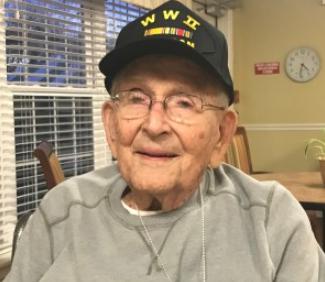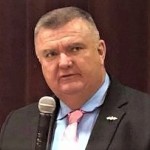By: John Cuddy – Feb. 2019
 Haverhill’s Anthony J “Tony” Zukas lived at Haverhill Crossing on Amesbury Road near Northern Essex Community College when I interviewed him. The students at Northern Essex Community College, and all of us really, can learn much from this World War II Veteran. Originally, from Scranton, Pennsylvania, he was the oldest in his family of fourteen children and dropped out of high school to help support the family during the Great Depression of the 1930s. First serving in the Pennsylvania National Guard, he later enlisted in the Regular US Army, and spent the war protecting the vital Allied strategic interests at the Panama Canal.
Haverhill’s Anthony J “Tony” Zukas lived at Haverhill Crossing on Amesbury Road near Northern Essex Community College when I interviewed him. The students at Northern Essex Community College, and all of us really, can learn much from this World War II Veteran. Originally, from Scranton, Pennsylvania, he was the oldest in his family of fourteen children and dropped out of high school to help support the family during the Great Depression of the 1930s. First serving in the Pennsylvania National Guard, he later enlisted in the Regular US Army, and spent the war protecting the vital Allied strategic interests at the Panama Canal.
Typical of our Greatest Generation, the man who never finished high school could do anything! He built his family home in Haverhill by hand, to quote Tony, “I touched every board and nail myself”. He also built his own reflective telescope, to gaze at the stars. For most of his life, he held a HAM Radio License; he operated his radio as N1HDG. Tony loved to garden with his wife Frances. He and his wife were widely known for the orchids raised in their garden. Tony built his wife Frances a greenhouse on their property in Haverhill. He was also active in the Knights of Columbus, a Catholic Fraternal organization focusing on strengthening Catholic families. Besides carpentry, astronomy, and gardening, Tony also enjoyed painting and golf.
Tony Zukas spent most of his Second World War service protecting the Canal with the US Army’s 33rd Infantry Regiment. How safe was this duty in Central America during the war? Both the Germans and the Japanese wanted to attack the Panama Canal. The German’s had code-named their secret, project for disabling of the canal, Operation Pelikan. The plan also known as Project 14, and was the Nazi’s bold plan for attacking the Panama Canal during World War II. During the fall of 1943, the German Wehrmacht had completed preparations to haul two Ju 87 Stuka Dive Bombers with folding wings on two U-boats to an unnamed Colombian island near the coast of Panama. Then the Germans would reassemble the planes, arm them with “special bombs”, and send them to attack the Panama Canal’s Gatun Dam. To learn more about this forgotten chapter of World War II, I recommend reading Stan Cohen’s “They came to Destroy America” or Ladislas Farago’s work “The Game of the Foxes”.
How and why Tony and the rest of the US Troops guarding the Panama Canal avoided attack by either the Germans or the Japanese is a mystery. The French started construction on the canal in 1882; they found the job dangerous and difficult. The United States took over in 1904 and finished just in time for the start of World War I in 1914. Many in the global community considered this seizing of the Canal, an act of war between the United States and Columbia. At the time, Panama was part of Columbia. The first ship to transit the canal, the SS Ancon, passes through on August 15, 1914. Guarding the Canal was tasked to the US Military. Panamanian unrest culminated in riots on Martyr’s Day, January 9, 1964, when over twenty Panamanians and several US soldiers were killed. Twenty-three more US Troops were killed in the 1989 invasion of Panama to remove dictator Manual Noriega known as Operation Just Cause directed by President George H. W. Bush.
After coming home from the Second World War, Tony worked for Western Electric and Lucent, first in Newark, New Jersey, and later wrapping up a 40+-year career at the North Andover plant. The men and women of our Greatest Generation grew up during the Great Depression, as young men and women they fought a two front Global war, then they simply came home and raised families. More often than not, our World War II Veterans spent the rest of their careers working for the same company. Most of these men, stayed married to the same woman too. During my interviews for this newspaper, I am coming across 50, 60, and even 75-year marriages.
Tony enjoyed talking to me about his siblings, his children, his grandchildren, and his great grandchildren. An American Hero, both during the War for defending our Nation, and after the war for quietly building his home. (He boasted to me, that he built it without permits from the City of Haverhill) and with his wife, focused on raising his family.
Sadly, two weeks ago Tony passed on after 102 years, shortly after our meeting. Our Nation and the Merrimack Valley are better for having known Tony. Married for 60 years to his late wife Frances, the couple had two daughters, four grandchildren, and six great grandchildren. I am very glad I was able to meet, and have a cup of coffee with Tony. The Valley Patriot thanks Craig Crom and Carol Arnold of Haverhill Crossing for their invaluable assistance with this article. We ask the Valley Patriot readers to, like Tony, become more engaged in their community, and be involved with your children and grandchildren’s team and clubs. Join organizations such as the Knights of Columbus and the American Legion and help make your community better. Do you want to live as long as Tony did? Simply love your family, garden, and play lots of golf! What an honor and privilege to meet him!

John Cuddy served in the US Navy’s Construction Battalions (known as the Seabees) after retiring from the US Navy; he used his GI Bill and earned a BA in History and an MA in Economics from the University of Massachusetts on the Lowell Campus. For the last twenty-two years, he has been employed in Logistics at FedEx. If you know a World War II Veteran who would like their story told, please email him at John.Cuddy@Yahoo.com ◊
